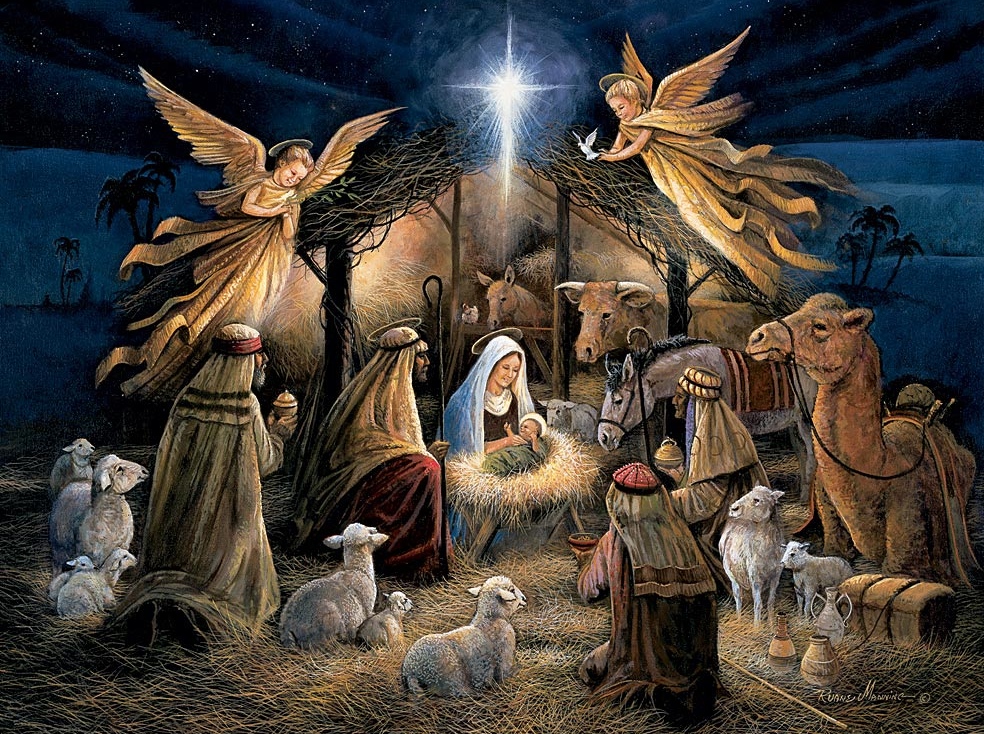 According to Christian tradition, the Nativity of Jesus refers to the biblical accounts of the birth of Jesus in the canonical Gospels of Matthew and Luke, and secondarily in some apocryphal texts. In the gospels according to Matthew and Luke both describe Jesus as being born in Bethlehem (Judea) to a virgin mother named Mary. This is where the similarities end.
According to Christian tradition, the Nativity of Jesus refers to the biblical accounts of the birth of Jesus in the canonical Gospels of Matthew and Luke, and secondarily in some apocryphal texts. In the gospels according to Matthew and Luke both describe Jesus as being born in Bethlehem (Judea) to a virgin mother named Mary. This is where the similarities end.
In this story the focus is placed upon men [from the East] who "follow a bright star in the sky". Some believe these men were astronomers (wisemen), while others proclaim them to be kings from far away lands. They are referred to as "the Magi". While the number of Wisemen who made the trip to Bethlehem is not known (the Bible does not give an exact count), Western tradition claims there were three. This is most likely rooted in the fact that they [the Magi] delivered three gifts to the baby child known as Jesus. They are ascribed as saying "they have come to worship the new King of the Jews and bring gifts" (Matthew 2:) to the child whom was called " "Emmanuel." (Matthew 1:23) When King Herod hears the news, he summons these wisemen to his palace and asks them about the whereabouts of this new-born king.
"Then Herod, when he had privily called the wise men, enquired of them diligently what time the star appeared. And he sent them to Bethlehem, and said, Go and search diligently for the young child; and when ye have found him, - bring me word again, that I may come and worship him also." ~ Matthew 2:7-8
"And when they (the wisemen) were departed, behold, the angel of the Lord appeareth to Joseph in a dream, saying, Arise, and take the young child and his mother, and flee into Egypt, and be thou there until I bring thee word: for Herod will seek the young child to destroy him." ~ Matthew 2:13
The Gospel of Luke
In this gospel, Joseph and Mary, who is heavy with child, are forced to travel to the city of Bethlehem to be taxed.
"And it came to pass in those days, that there went out a decree from Caesar Augustus that all the world should be taxed. (And this taxing was first made when Cyrenius was governor of Syria.) And all went to be taxed, every one into his own city. And Joseph also went up from Galilee, out of the city of Nazareth, into Judaea, unto the city of David, which is called Bethlehem; (because he was of the house and lineage of David):" ~ Luke 2:1-4
Not long after Joseph and Mary arrived in the City of David, Joseph's virgin wife delivered her child, who was called Christ the Lord. According to the scribe, Jesus was "wrapped in swaddling clothes and laid in a manger; because there was no room at the inn." (Luke 2:7) Some theologians interpret this to mean the Christ child was born in a stable, while other scholars believe it could have possibly been a cave where the birth occurred.
"And all they that heard it wondered at those things which were told them by the shepherds." ~ Luke 2:18
=========================================================
Per Wikipedia.com
The main religious celebration among members of the Catholic Church and other Christian groups is the Church service on Christmas Eve or on the morning of Christmas Day. During the forty days leading up to Christmas, the Eastern Orthodox Church practices the Nativity Fast, while the majority of Christian congregations (including the Catholic Church, the Anglican Communion, many Mainline churches, and Baptists) begin observing the liturgical season of Advent four Sundays before Christmas. Both are seen as times of spiritual cleansing, recollection and renewal to prepare for the celebration of the birth of Jesus.
In Christian theology, the Nativity of Jesus concerns the Incarnation of Jesus as the second Adam, in fulfillment of the divine will of God, undoing the damage caused by the fall of the first man, Adam. The artistic depiction of the Nativity has been a major subject for Christian artists since the 4th century. Since the 13th century, the Nativity scene has emphasized the humility of Jesus and promoted a more tender image of him, as a major turning point from the early "Lord and Master" image, affecting the basic approaches of Christian pastoral ministry.
The theological significance of the Nativity of Jesus has been a key element in Christian teachings, from the early Church Fathers to 20th century theologians. The theological issues were addressed as early as Apostle Paul, but continued to be debated and eventually lead to both Christological and Mariological differences among Christians that resulted in early schisms within the Church by the 5th century.
=========================================================
There are many modern scholars, such as E. P.Sanders, and Marcus Borg, who consider both narratives to be non-historical, arguing that there are contradictions between them. On the other hand, biblical scholar Mark D. Roberts aims to establish a harmonised account of the birth of Jesus, maintaining that any contradictions can be reconciled. Then there are other biblical theologians who view the discussion of historicity as secondary, given that the gospels were primarily written as theological documents rather than historical accounts.
No comments:
Post a Comment